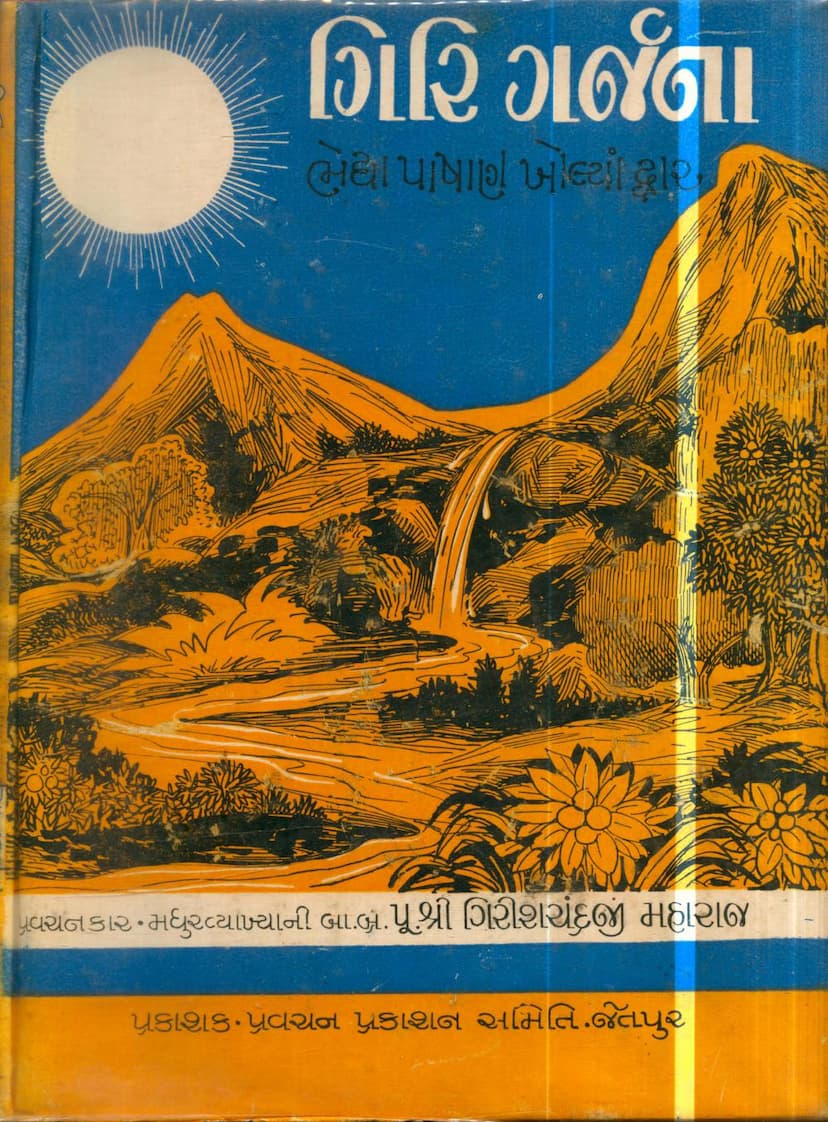Giri Garjana
Added to library: September 1, 2025

Summary
This is a comprehensive summary of the Jain text "Giri Garjana" by Girishchandra Maharaj, based on the provided pages. The text appears to be a collection of discourses or lectures, possibly given during a Chaturmas (a four-month period of religious observance), focusing on various aspects of Jain philosophy, ethics, and spirituality.
Here' is a breakdown of the key themes and elements covered in the text:
1. Title and Author:
- Title: Giri Garjana (ગિરિ ગર્જના - meaning "Mountain Roar" or "Roar of the Mountain")
- Subtitle: Bhedya Pashana; Kholya Dwar (ભેદ્યા પાષાણ; ખોલ્યાં દ્વાર - meaning "Broken Stones; Opened Doors"). This suggests a theme of breaking through ignorance or barriers to reach deeper spiritual understanding.
- Author/Speaker: Girishchandra Maharaj (ગિરીશચંદ્રજી મહારાજ), described as a "Madhur Vyakhyani" (મધુર વ્યાખ્યાની - one who delivers sweet discourses) and a disciple of Ba. Brahmachari Shri Jayantilalji Maharaj, who was a disciple of Saurashtra Kesari Ba. Brahmachari Shri Pranalalji Maharaj. This lineage highlights a respected spiritual tradition.
- Publisher: Pravachan Prakashan Samiti, Jetpur (પ્રવચન પ્રકાશન સમિતિ, જેતપુર).
2. Core Textual Focus:
- The text is a collection of discourses based on the Uttaradhyayan Sutra, specifically the 23rd Chapter, "Keshi Gautamiy".
- This chapter is noted for its historical significance in Jainism, detailing a dialogue between Keshikumara, a disciple of Lord Parshvanath, and Gautama, a chief disciple of Lord Mahavir.
- The discourses also highlight how Lord Mahavir introduced reforms to existing religious practices, possibly based on the traditions of the 23rd Tirthankara, Lord Parshvanath, to revitalize Jainism.
3. Key Themes and Concepts Explored (as indicated by the extensive index and introductions): The book delves into a wide array of spiritual and philosophical topics, including:
- Core Jain Principles: The book emphasizes fundamental Jain tenets such as the importance of Samayika (equanimity), Samyak Darshan (right faith), Jnana (knowledge), Kriya (action), Tapas (austerity), Sanyam (restraint), Ahimsa (non-violence), Anekantavada (non-absolutism), Syadvada (conditional predication), and the concept of Moksha (liberation).
- The Nature of Reality: Discussions on the self (Atma), the ultimate reality (Paramtattva), the relationship between Jiva (soul) and Ajiva (non-soul), and the illusion of Mithyatva (false views).
- Ethical Living: Emphasis on virtues like truthfulness, non-violence, restraint, generosity, forgiveness, and the importance of righteous conduct.
- Spiritual Practices: Explanations of various practices like Sanyam (restraint), Tapas (austerity), Japa (chanting), Dhyana (meditation), and Samayika (equanimity in Jainism).
- Life and Death: Reflections on the cycle of birth and death (Chaurasi Laksh Yoni), the fear of death, and the path to immortality.
- The Self and the Divine: Exploring the concept of the soul (Atma) as the true self, its divine potential, and the path to realizing the Paramtattva (Supreme Being).
- The Role of Scriptures (Agamas): The text emphasizes the Agamas as a guiding light for life, comparing them to a lamp (Jivan-Deepak) illuminating the path to liberation.
- The Importance of Conduct: The book stresses that mere intellectual knowledge (Jnana) is insufficient; it must be accompanied by righteous action (Kriya) and sincere practice.
- The Nature of Wealth: Discussing what constitutes true wealth (Saccha Dhan) beyond material possessions.
- The Power of Words: Exploring the impact and importance of speech (Vani ki Prabuta).
- Festivals and Observances: References to festivals like Raksha Bandhan, Janmashtami, Paryushan, and Samvatsari, highlighting their spiritual significance and meaning.
- Philosophical Concepts: Discussions on Naya (standpoints), Naya-vada (the theory of standpoints), Saptabhangi (the doctrine of sevenfold logic), Pramana-vada (the theory of knowledge), and the concept of Anekanta (non-absolutism).
- The Speaker's Style: The discourses are described as having eloquent language, profoundness, depth, and a style that connects philosophical concepts to practical life, making them engaging and attractive to listeners.
4. Structure and Content:
- The book is a voluminous work, indicated by its 720 pages.
- The detailed index (Anukramanika) reveals a systematic approach, covering a vast range of subjects.
- The content is structured into various chapters or sections, each likely dedicated to a specific theme or topic, often presented through philosophical exposition, examples, and allegories.
- The publication date is mentioned as Mahavir Jayanti V.S. 2033 / Vir Samvat 2503, indicating its release shortly after Lord Mahavir's birth anniversary.
5. Supporting Materials:
- The book includes introductory sections like a "Publishers' Note" (Prakashkiya), "Editor's Note" (Sampadkiya), and an "Introduction" (Aamukh) written by prominent figures like Shri Harasukhbhai Sanghvi, Vice-Chancellor of Saurashtra University.
- It also features appreciations and tributes, including a brief biography of Saurashtra Kesari Pujya Shri Pranalalji Maharaj and a list of benefactors (Sahayogi ane Saunjanyashil Bhavyatmano ni Shubha Namavali).
- The text also includes prayers and devotional verses dedicated to the gurus and spiritual lineage.
In essence, "Giri Garjana" is a comprehensive and profound exploration of Jain teachings, presented through the eloquent discourses of Girishchandra Maharaj. It aims to guide seekers towards spiritual upliftment and self-realization by illuminating the path to liberation through the lens of the Uttaradhyayan Sutra and other related philosophical concepts.